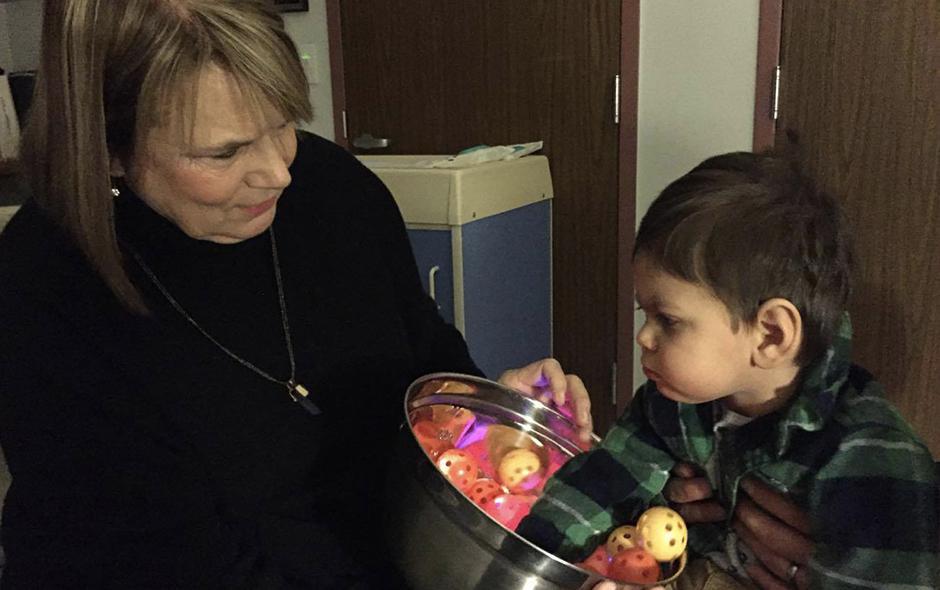

Making progress with vision using a CVI Schedule

Jonathan Graves

Cortical Visual Impairment is the most prevalent form of visual impairment among children from developed countries.i CVI is unique among visual impairments because it is one of the few conditions that can actually improve with the right assessment and intervention.ii Because it is a brain-based neurological vision impairment, CVI improves when a child has ample opportunity to view meaningful objects that are optimized for the child’s current level of visual function and visual characteristics. To find out more about identifying CVI, understanding the visual characteristics, and the CVI Range, check out my blog post, What is Cortical Visual Impairment?
Developing the CVI Schedule
Once a child with CVI is assessed by someone trained in the CVI Range and they receive a Range score, the real work begins. The CVI schedule is a list of activities and routines that happen throughout the child’s day, and that could include a visual element. For each activity, the CVI professional helps develop modifications to that activity based on the child’s CVI Range to encourage the child to use their vision when they might otherwise not be able to.
Parents should play a large role in creating the list of activities in the child’s routine, and describing how these activities work at home. When the routine begins with the family, there is a greater likelihood that accommodations made by the vision professional will be implemented and successful.
Begin with a list of typical activities that are already part of the family’s day. These may include a wake up routine, toileting, choosing clothes, having breakfast, playtime, reading activities, riding in the car, home therapy activities, bath time, the evening meal, visiting family members, and the bedtime routine.
Here are some guidelines for creating a CVI Schedule:
- Divide the day into four parts, (Morning, Midday, Afternoon, Evening) and target two activities in each part of the day, for a total of eight activities to start with. The vision professional can help develop additional schedule activities as the daily routine and the child’s vision evolve. Begin with a manageable number of activities to target with accommodations, adding more when the routine feels comfortable and familiar. The goal is to create accommodations for as much of the child’s day as possible. Children never turn off their vision, so the more opportunities they have to make direct eye-to-object contact with meaningful objects, the more their visual pathways are reinforced.
- Don’t change what you do – just change how you do it. Sometimes all a child needs to see a familiar object are a few subtle changes to how its presented. Strategies can include:
- Present a toy against a black background to limit complexity
- Wait up to thirty seconds or more for the child to turn towards it or reach for it
- Holding the toy within the child’s preferred visual field
- Incorporating a small amount of movement into the object
- Adding light to the object
- Allowing for silence while the child works to process what they see.
- There are ways to adapt the visual environment without remodeling the whole house. Create a visually quiet space using a black tri-fold board, or hang a small black curtain on a rod to provide a black background. Place this behind you during visual tasks, and slide it out of the way when you are finished. Decrease visual complexity by lowering the main lights and adding light to the object with a flashlight or flexible task light. Turn off the TV or music in the room, and ask family members to stay quiet during looking tasks. Provide language and praise when you introduce the task, and several seconds after the child stops looking. A “black out” tent, can help create a pop-up low complexity space for vision tasks, so that visual clutter in the room does not interfere with the child’s visual processing.
- Share successes and concerns. Talk to your CVI professional about activities that work well, and where there are still challenges. Sharing video of the task is very helpful, and the CVI professional may be able to see opportunities to adjust the task to make it more successful. Your child’s successes form a foundation of mastered skills that new activities can be built upon.
- Show the routine to everyone who is meaningful in the child’s life. As your child develops new visual skills, the whole family can get involved in helping your child to see the world around them, if they understand how to use the strategies that help make your child successful.
- Expect improvement. Children with CVI are in a unique position to make gains in their vision through careful assessment and thoughtful intervention. This happens when members of the child’s team believe that the child will make improvements, and nurture those improvements as they happen.
Parents make incredible Therapists
Vision professionals contribute immensely to a child’s visual journey by modifying toys and activities, refining presentation techniques, and tracking progress through assessment. However, the work done at home in the family has the biggest impact on improvement of vision for children with CVI. There are several reasons for this:
- Parents know their children best. They understand what their children prefer and what they avoid, when they are tired and when they are hungry. More valuable than any IEP or therapy plan, parents are armed with goals and dreams for their children which support them as they push through perceived limitations. When children make even the smallest progress, parents celebrate it with the memory of how far they have come and expectations of how far they still will go. A CVI schedule built around a child’s preferences, respectful of their limitations, and strengthened by expectations of growth and development is far more likely to be successful.
- Parents design the family routine. Just as each child is an individual, each family operates in its own unique way, and parents are responsible for these decisions. From setting the morning schedule to choosing meals and mealtimes, parents are constantly balancing the needs of every member of the family.
- Parents are the observers of challenges and opportunities. Parents notice when children are having a hard time viewing or participating in a task. An accommodation that worked at school or in a clinic might not work at home, and parents play an important role in helping to figure out why. Similarly, as parents develop a better understanding of the factors that help their children see, they can take advantage of opportunities to introduce new objects, make connections between one activity and another, and reinforce the progress the child has already made.
- Parents can support vision more often, and more effectively. Children with CVI make progress when they are presented with visual targets which accommodate their current level of function. Direct eye-to-object contact, and visually guided interaction is the best way to make progress. Children don’t turn their vision off in between therapy sessions. They need quality opportunities to use vision while engaged in meaningful activities throughout their whole day. Parents are uniquely equipped to provide these interactions from the moment the child wakes up to the time they go to bed.
- Parents and vision professionals are partners. By adding the overlay of CVI to a child’s routine, parents help to facilitate great progress in their children. Throughout this process, the family should have ongoing support and consultation from their child’s CVI professional. With a strong, open relationship, therapists and families can brainstorm solutions to challenges, talk about difficulties, and celebrate successes. Through collaboration, the CVI schedule can be inspiring, rather than overwhelming.
The expectation of improvement is the hallmark of CVI.– Ellen Cadigan Mazeliii
Sources:
- Kong, L., Fry, M., Al-Samarraie, M., Gilbert, C., & Steinkuller, P. G. (2012). An update on progress and the changing epidemiology of causes of childhood blindness worldwide. Journal of American Association for Pediatric Ophthalmology and Strabismus,16(6), 501-507. doi:10.1016/j.jaapos.2012.09.004
- Roman-Lantzy, C. (2007). Cortical visual impairment: An approach to assessment and intervention (First ed.). New York, NY: American Foundation for the Blind Press.
- Cadigan Mazel, E. (2014, December 12). Expect Improvement! Retrieved July 31, 2018, from https://cviteacher.wordpress.com/2014/12/12/expect-improvement/


